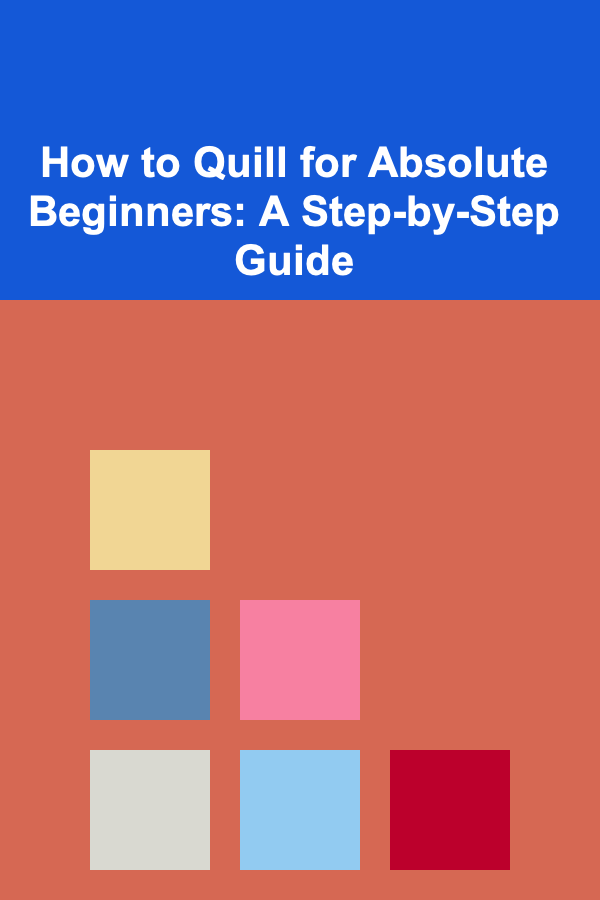
How to Quill for Absolute Beginners: A Step-by-Step Guide
ebook include PDF & Audio bundle (Micro Guide)
$12.99$10.99
Limited Time Offer! Order within the next:

Quilling, also known as paper filigree, is a craft that involves rolling, shaping, and gluing strips of paper to create intricate designs. It's a relaxing and rewarding activity that allows you to express your creativity. Whether you're looking to create decorative pieces for your home, cards for special occasions, or even personal gifts, quilling can be an exciting way to get started with paper crafts.
In this comprehensive guide, we will walk you through everything you need to know to begin quilling as an absolute beginner. By the end of this guide, you'll have a clear understanding of the basic tools, techniques, and ideas to create your own stunning paper art.
What You Need to Get Started with Quilling
Before you dive into the craft, it's essential to have the right tools. Fortunately, quilling doesn't require much---just a few basic supplies to get you started.
1. Paper Strips
The main material used in quilling is, of course, paper. You can purchase pre-cut quilling paper strips, or you can cut your own strips from a standard sheet of paper. Here are some tips:
- Width: Quilling paper strips typically come in various widths, such as 1/8-inch, 1/4-inch, and 1/2-inch. Beginners often start with 1/8-inch strips as they are easier to work with and create delicate designs.
- Length: Standard strips are usually about 12 inches long, but you can adjust the length according to your design needs.
- Color: Quilling paper comes in a variety of colors. You can choose single colors or multicolored strips, depending on the effect you want to achieve.
2. Quilling Tool
The quilling tool is the most essential piece of equipment. It's typically a small tool with a slot at the end where you can insert the paper strip to roll it. There are two main types of quilling tools:
- Needle tool: Ideal for tight rolls and smaller designs.
- Slotted tool: Great for creating both tight and loose rolls.
While a quilling tool makes the process smoother, you can also use a simple toothpick or a pin if you're just starting and don't want to invest in special equipment.
3. Glue
A strong adhesive is necessary to keep your quilled shapes in place. You can use any of the following:
- PVA glue (white glue): This is the most common and works well for most quilling projects. It dries clear and doesn't leave any visible marks.
- Glue pen: These are easy to control and less messy than using liquid glue. They allow for more precision when working on smaller designs.
4. Scissors
Scissors are essential for trimming paper strips to the correct size and shape. A good pair of sharp scissors will help you cut clean, straight lines.
5. Quilling Board (Optional)
A quilling board has slots for shaping your quilled paper into specific sizes. It helps create even shapes and is particularly useful when you're just starting out and want uniform results. However, it is not essential for beginners, and you can use your hands or any other surface.
6. Tweezers (Optional)
Fine-tipped tweezers are helpful for handling tiny quilled pieces, especially when your design gets more intricate. They can also help adjust the shape and placement of your quilled components.
Basic Quilling Techniques for Beginners
Now that you have the tools, let's explore the core techniques of quilling that you will need to master.
1. Rolling the Paper
Rolling paper is the foundation of all quilling designs. You will start by rolling a strip of paper into a tight coil, then loosen it to the desired shape. Here's how you do it:
- Insert the Paper Strip: Place one end of your paper strip into the slotted tool.
- Roll the Paper: Turn the tool slowly, allowing the paper to curl tightly around the tool. Keep the coil tight, but don't roll too fast, as it may distort the shape.
- Glue the End: Once you've rolled the entire strip, apply a small amount of glue to the end of the strip and press it down to secure it in place.
Pro Tip: If you're new to quilling, try using shorter strips to make smaller coils. The more you practice, the more consistent your coils will become.
2. Creating Loose and Tight Coils
The difference between loose and tight coils lies in how tightly or loosely you roll the paper.
- Tight Coils: After you've rolled the paper, don't loosen it; keep the coil tightly wound. Tight coils are used as the base for many other shapes.
- Loose Coils: If you want a looser, wider coil, gently loosen the coil after it's rolled, then let it expand to the size you want. Once you reach the desired size, glue the end to secure it.
3. Shaping Coils
Once you have your coil (whether tight or loose), you can shape it into various forms by gently pinching the sides or flattening it. Some common shapes include:
- Teardrops: Pinch one side of the coil to form a teardrop shape. This is used for creating petals or leaves.
- Squares: Pinch opposite sides of a loose coil to form a square.
- Hearts: Pinch two sides of the coil and curve them to form a heart shape.
- Ovals: Gently pinch both ends of the coil to create an oval shape.
These basic shapes will be the foundation for most of your quilling projects.
4. Combining Shapes
Once you've mastered rolling and shaping individual coils, you can begin combining them to create more complex designs. For example, you can place multiple teardrop shapes together to create flowers, or arrange various shaped coils in a circular pattern to make a mandala.
To combine shapes, simply apply glue to the edges and press them together. Make sure to let each layer dry before adding another to ensure stability.
Simple Quilling Projects for Beginners
Now that you've learned the basic techniques, it's time to start creating your first quilling projects. Here are some simple ideas to get you started:
1. Quilled Flowers
One of the easiest designs to begin with is a quilled flower. To make a basic flower:
- Roll several tight coils in different colors.
- Shape them into petals by pinching the ends to form teardrop shapes.
- Arrange the petals into a flower shape and glue them together at the center.
- Add a circular coil for the flower's center.
You can experiment with different flower designs, like daisies or roses, by altering the number and shape of the petals.
2. Quilled Cards
Quilled cards are a popular choice for beginners and make great gifts for birthdays, weddings, or other special occasions. To make a simple quilled card:
- Cut a blank card and use the quilling techniques to make a small design (such as a flower, butterfly, or heart).
- Glue your design to the front of the card.
- Add a greeting or personal message to complete the card.
This project allows you to experiment with various shapes and arrangements while creating a meaningful gift.
3. Quilled Frames
Quilled photo frames are another creative and useful project. To make a quilled frame:
- Start with a basic wooden or cardboard frame.
- Use quilled shapes (such as flowers, leaves, or abstract designs) to decorate the frame's edges.
- Secure the quilled pieces with glue and allow the design to dry before adding a photo.
This project can be as intricate or as simple as you like, depending on the design you choose.
Tips for Successful Quilling
As a beginner, quilling might seem a bit challenging at first, but with practice, it becomes easier. Here are some tips to help you succeed:
- Practice Makes Perfect: Your first few quilled pieces may not look perfect, and that's okay! The more you practice, the more comfortable you'll become with the techniques.
- Start Simple: Don't overwhelm yourself with complicated designs right away. Start with basic shapes and simple projects, then gradually move on to more intricate pieces.
- Use a Light Hand: When rolling or shaping your paper, be gentle. Too much force can cause the paper to rip or distort the shape.
- Experiment with Colors: Quilling allows for endless color combinations. Experiment with different hues and shades to see how they complement each other.
Conclusion
Quilling is an enjoyable and versatile craft that can be used to create everything from cards and home décor to intricate works of art. By learning the basic techniques of rolling, shaping, and gluing paper, you'll be able to create beautiful, personalized designs that showcase your creativity.
Start small, be patient, and most importantly, have fun. With practice and experimentation, you'll quickly progress from beginner to advanced quiller, discovering new techniques and design possibilities along the way.
Happy quilling!
Reading More From Our Other Websites
- [Home Holiday Decoration 101] How to Use Vintage Holiday Decor to Add Charm to Your Home
- [Home Soundproofing 101] How to Use Acoustic Panels to Soundproof Your Living Room
- [Home Soundproofing 101] How to Soundproof Your Home's Floors to Block Out Footsteps
- [Hiking with Kids Tip 101] How to Teach Kids Navigation Skills on Multi‑Day Hikes Without Using a GPS Device
- [Home Budget 101] How to Save on Utility Bills with Simple Home Adjustments
- [Personal Care Tips 101] How to Choose the Best Soap for Oily Skin?
- [Personal Finance Management 101] How to Use the Debt Avalanche Method to Pay Off Debt Faster
- [Home Lighting 101] How to Style Shelves with Accent Lighting
- [Home Storage Solution 101] How to Use Clear Storage Containers for Easy Access and Visibility
- [Home Staging 101] How to Stage Your Home's Exterior to Make a Great First Impression

How to Observe Owls in Their Natural Habitat
Read More
How to Enhance Your Problem-Solving Speed with Brain Hacks
Read More
Mastering Public Speaking for Sales Pitches: A Comprehensive Guide
Read More
Exploring the Truth Behind Ancient Technologies
Read More
How to Eat Seasonally for Fresher Produce
Read More
How to Plan for Student Assessments with Your Classroom Planner
Read MoreOther Products

How to Observe Owls in Their Natural Habitat
Read More
How to Enhance Your Problem-Solving Speed with Brain Hacks
Read More
Mastering Public Speaking for Sales Pitches: A Comprehensive Guide
Read More
Exploring the Truth Behind Ancient Technologies
Read More
How to Eat Seasonally for Fresher Produce
Read More